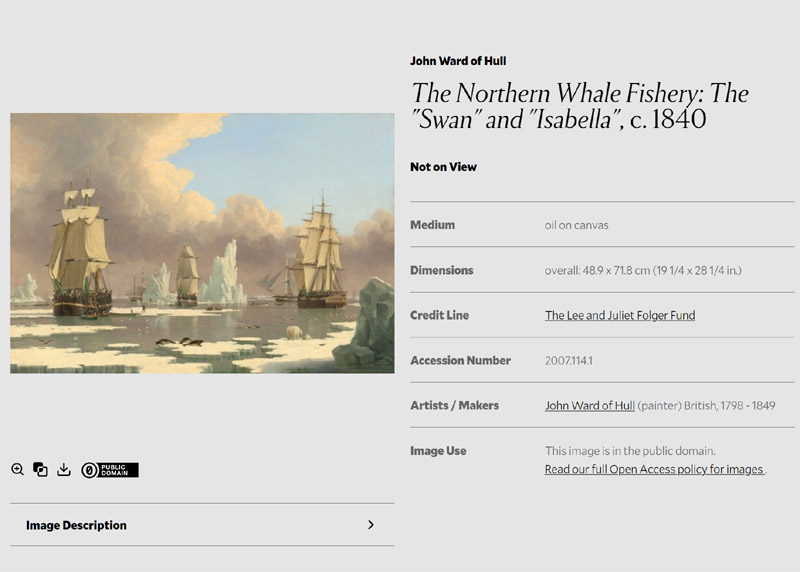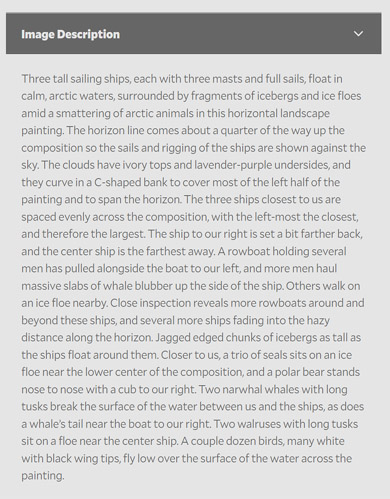The art of writing descriptions
Lorena Bradford, Manager of Accessibility Programs, National Gallery of Art, Washington DC, discussed a project relating specifically to visually impaired visitors which involved creating detailed descriptions of objects in their collection which appear in a dedicated field on the object record displayed online. Only the visual qualities were captured. This meant discarding information regarding technique, people or historical context, except in exceptional circumstances. And artist names were only mentioned if signatures were visible.
The process ran as follows: guidelines for the process were produced, informed by the disabled community and external consultants. A pilot phase then commenced in the summer of 2020 involving an initial group of 30 authors from 25 departments. This was later expanded to all staff, volunteers and docents.
The main goal of the project was generating textual description. Allied to that was training authors to write descriptions, as well as sharing the resources with the wider museum community.
Authors tried their hand at writing two sample descriptions for which Lorena provided feedback. This was followed up by interactive authoring workshops where groups would edit draft object descriptions together. After that they worked on their own timeline, supported by regular editorial drop-in clinics and the sharing of collated tips and general best practise around specialist object types. As she put it, authors were “on their own but never alone”.
Eventually more than 130 authors were trained across 30 departments and there are about 20 authors active at any one time. Lorena stressed that working with people has been as important as the writing process itself. Currently there are 1200 descriptions live on the website and the selection process was based on the most visited artworks.
Two actual author responses are reproduced below:
“I’ve thought about how to balance extremely clear, unbiased writing with more colourful and engaging prose. It’s also challenged me to expand my usual vocabulary!”
“I feel we’re continuously confronted (or at least I know I am) with our long-standing assumptions and defaults that either don’t best serve our public and our mission or can actually alienate. I’ve become more aware as I’ve participated in this initiative and try to incorporate these lessons and skills into other aspects of my work.”
The image descriptions are long and detailed and can be found by clicking the “Image Description” link under the image. Lorena’s feeling, after discussing the project with stakeholders, was that these descriptions should, as she put it, be “evergreen” and “honour the works of art”. The format, layout and content have been tested with both the visually impaired and sighted communities so that it benefits everyone.
Example
The Northern Whale Fishery: The “Swan” and “Isabella”, c. 1840
Image description
Three tall sailing ships, each with three masts and full sails, float in calm, arctic waters, surrounded by fragments of icebergs and ice floes amid a smattering of arctic animals in this horizontal landscape painting. The horizon line comes about a quarter of the way up the composition so the sails and rigging of the ships are shown against the sky. The clouds have ivory tops and lavender-purple undersides, and they curve in a C-shaped bank to cover most of the left half of the painting and to span the horizon. The three ships closest to us are spaced evenly across the composition, with the left-most the closest, and therefore the largest. The ship to our right is set a bit farther back, and the center ship is the farthest away. A rowboat holding several men has pulled alongside the boat to our left, and more men haul massive slabs of whale blubber up the side of the ship. Others walk on an ice floe nearby. Close inspection reveals more rowboats around and beyond these ships, and several more ships fading into the hazy distance along the horizon. Jagged edged chunks of icebergs as tall as the ships float around them. Closer to us, a trio of seals sits on an ice floe near the lower center of the composition, and a polar bear stands nose to nose with a cub to our right. Two narwhal whales with long tusks break the surface of the water between us and the ships, as does a whale’s tail near the boat to our right. Two walruses with long tusks sit on a floe near the center ship. A couple dozen birds, many white with black wing tips, fly low over the surface of the water across the painting.


[…] Read Alex’s notes on writing object descriptions […]